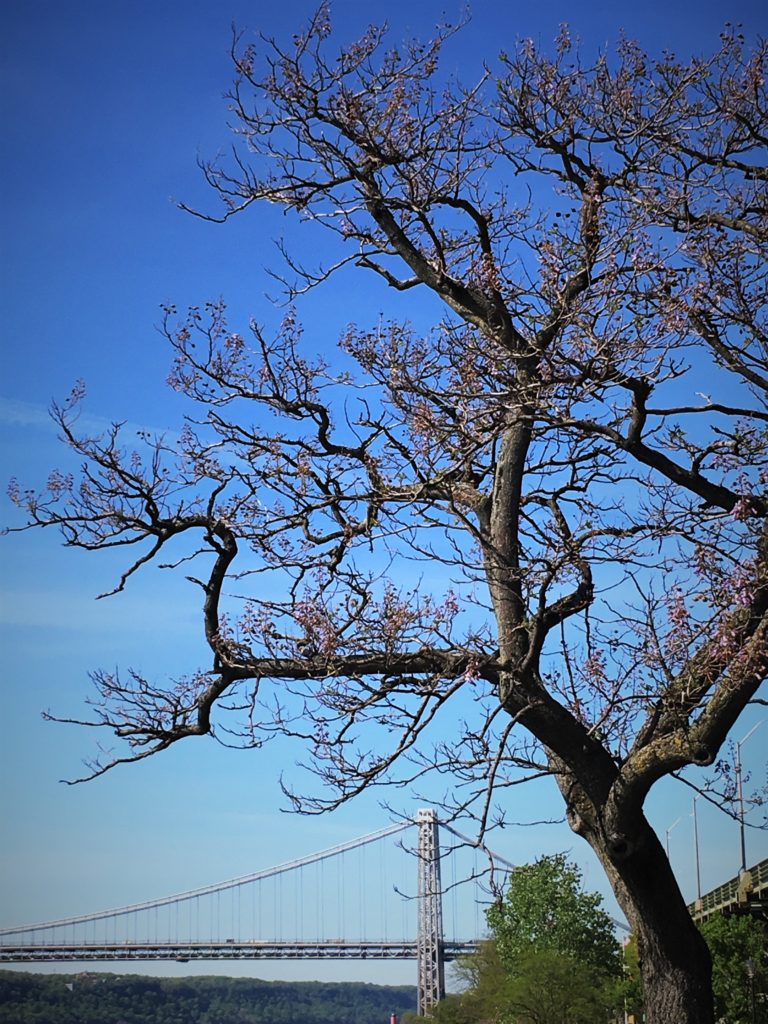In Northern United States, crocuses and daffodils break through the ground every March announcing the return of spring. Within weeks, blossoming trees follow with white and pink pom-poms, reassuring folks that warmer days are nearing. By the end of April, when light green leaves fill up the clearings between branches, anticipations of the new growing season morph into excitements for summer planning. People stop paying attention to trees. I, however, always look forward to the months of May to see my favorite trees in bloom.

The first spring after moving into the neighborhood, I noticed a tree in the vacant yard at the corner of our street, standing on a small patch of soil against the wall of the apartment building, leafless but full of clusters of purple flowers. Soon, I realized that it wasn’t alone. There were a few more purple trees on the other side. Their blossoming branches protruded above the arch of subway entrance. And, it was very likely that they were offspring of a great tree in the backyard of the building on top of the hill. Out of curiosity, I looked them up online.
Officially Paulownia tomentosa, they are listed on New York City Street Tree Map under Princesstree.[1] Also known as empress trees or royal paulownias,[2] they have the beauty and grandeur to match these names. These royalties need no palaces. They find their ways into botanical gardens[3]; in courtyards; in the rubble of collapsed buildings; alongside railroad tracks; on rocky cliffs and sandy riverbanks. Given enough space with the right conditions, they colonize and form purple canopies visible from a distance. Branded with the stigma of “invasive,” they are unwelcome in some states.


An invasive species is non-native; fast-growing and environmental changing. Paulownia has Asian roots. Because of its fast-growing nature, the wood of 泡桐 (pao-tung) is light-weight and fine-grained, suitable for use as soundboard of instruments. For centuries, it is essential in making Chinese zithers箏 (zheng) and 琴 (qin)—the latter is known to be the instrument for scholars and gentlemen. It is also used in furniture making. The word 桐 (tung) appears frequently in Chinese poetry, symbolizing melancholia and nostalgia. Although, most often, it refers to 梧桐 (wu-tung, Firmiana simplex), unrelated to paulownia,[4] there is a very specific mention of purple tung flowers in寒食江畔 (At Riverbank during Hanshi Festival), 白居易 (Bai Juyi, 772-846):

草香沙暖水雲晴,風景令人憶帝京。
Grass is fragrant, sand is warm, light wavy clouds on the clear sky;
The scenery makes one nostalgic of the empirical capital.
還似往年春氣味,不宜今日病心情。
Atmosphere of spring remains similar to the years past;
Yet it is discordant to my afflicted mind today.
聞鶯樹下沈吟立,信馬江頭取次行。
Standing underneath the trees, in deep laments, I listen to the bird song;
On the horse, along the river edge, I ride aimlessly.
忽見紫桐花悵望,下邽明日是清明。[5]
Unexpectedly seeing purple paulownia blossoms, I look at them with despair;
Tomorrow will be Qingming in Xiagui.
Was Paulownia invasive or native of North America? Was it imported to Northern America as ornamental trees or for its timber? When was it introduced to this land? There are different theories and arguments. Its ability to adapt and prosper seems to be a double-edge sword.


[1]New York Street Tree Map_Princesstree: Many trees shown on this map are actually Indian bean trees (Southern catalpa). The leaves of catalpa and paulownia are hard to distinguish.
[2]Paulownia-tomentosa-Missouri-Botanical-Garden
[3]Royal-Paulownia-NY-Botanical-Garden
[4]Firmiana-simplex-Missouri-Botanical-Garden
There is also 油桐 (Aleurites/Vernicia fordii, tung oil tree), cultivated for oil production and as ornamental plants. Tung Blossom Festivals take place in various regions in Taiwan every spring. Tung Blossom Photos
[5] Hanshi 寒食 takes place on the 105th day after Winter Solstice. It often falls on the day before Qingming 清明. Blossoms of Firmiana simplex are yellow green. So, clearly, Bai was describing the sight of paulownias.
